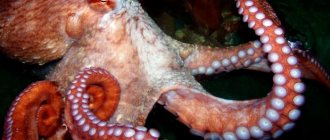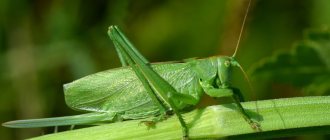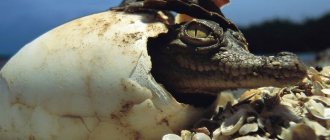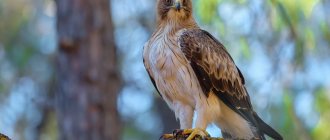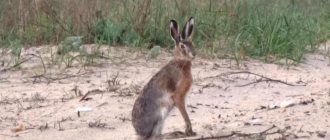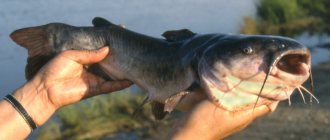- Wild animals
- >>
- Other animals
Tridacna is an impressive genus of the largest bottom-attached mollusk.
They are popular as a food source and for observation in aquariums. Tridacna species were the first aquacultured shellfish species. They inhabit coral reefs and lagoons where they can receive sufficient sunlight. In the wild, some giant tridacnids become so overgrown with sponges, corals and algae that their shape becomes unrecognizable! This has given rise to many myths and fears about “man-eating shellfish.” However, today we know that these prejudices are absurd. Tridacna is absolutely not an aggressive species.
Origin of the species and description
Photo: Tridacna
This subfamily contains the largest living bivalves, including the giant clam (T. gigas). They have heavy, fluted shells with 4–6 folds. The color of the mantles is extremely bright. They live on coral reefs in warm sea lagoons in the Indo-Pacific region. Most mollusks live in symbiosis with photosynthetic zooxanthellae.
Video: Tridacna
Sometimes giant mussels continue to be considered a separate family Tridacnidae, however, modern phylogenetic analysis has allowed them to be included as a subfamily in the Cardiidae family. Recent genetic evidence has shown that they are congeneric sister taxa. Tridacna was first classified in 1819 by Jean-Baptiste de Lamarck. He even placed them for a long time as a subfamily of the order Venerida.
Currently, ten species are included in two genera of the Tridacninae subfamily:
Genus Hippopus:
- Hippopus hippopus;
- Hippopus porcellanus.
Genus Tridacna:
- T. costata;
- T. crocea;
- T. gigas;
- T. maxima;
- T. squamosa;
- T. derasa;
- T. mbalavuana;
- T. rosewateri.
Various myths have been built around the tridacna since ancient times. To this day, some people call them "killers" and falsely claim that the giant clams attacked divers or other living creatures and held them in the depths. In fact, the closing effect of the clam valves is quite slow.
The fatal accident that was officially documented occurred in the 1930s in the Philippines. The pearl diver has gone missing. He was later found dead with his gear stuck in a 160kg tridacna. After it was brought to the surface, a large pearl was discovered in the hand, apparently from a shell. Trying to remove this pearl was fatal.
Angelfish / Clione limacina
The pteropod with such a romantic, almost biblical name is actually a predatory sea snail. And this angel hunts ocean devils, the same mollusks only from the genus Limacina.
Sea angels have a slightly elongated and completely transparent body. They live in the cold ocean waters of both earth's hemispheres, trying to stay at a depth of 500 m.
In Japan, the beautiful sea creature is a common character in children's fairy tales and stories. In the Land of the Rising Sun, the Sea Angel became the prototype for the creation of two 4th generation Pokemon - Manaphy and Fiona.
14
Appearance and features
Photo: What does tridacna look like?
Tridacna is the largest living bivalve mollusk. The shell can reach up to 1.5 meters in length. They are characterized by having 4 to 5 large, inward-facing triangular projections of the shell opening, thick, heavy shells without scutes (juveniles may have multiple scutes), and an inspiratory siphon without tentacles.
The mantle is usually golden brown, yellow or green with many iridescent blue, purple or green spots, especially along the edges of the mantle. In larger individuals there may be so many similar spots that the mantle appears from the outside to be a solid blue or purple color. Tridacnids also have many pale or clear spots on the mantle called "windows".
Fun fact: Giant tridacnids cannot completely close their shells when they grow up. Even when closed, part of the mantle remains visible, unlike the very similar Tridacnus deraza. There are always small gaps between the shells, through which the retracted brownish-yellow mantle is visible.
Young tridacnids are difficult to distinguish from other species of molluscs. However, this can only be recognized with age and growth. They have four to seven vertical folds in their shell. Bivalves containing zooxanthellae tend to grow massive shells of calcium carbonate. The edges of the mantle are filled with symbiotic zooxanthellae, which presumably use carbon dioxide, phosphates and nitrates supplied by shellfish.
Carronella pellucida
The list continues with another nudibranch representative of the marine world with a milky white body with crimson cerates.
The species lives on polyps along the Atlantic coast of the United States, and is also found in the English Channel and the North Sea. Like all many mollusks, it feeds on polyps. It reaches 4 cm in length. The small body contains a pair of rhinophores and slightly elongated oral tentacles.
This species was first discovered and scientifically described back in 1843 by American zoologists.
3
Where does tridacna live?
Photo: Tridacna at sea
Tridacniformes are found throughout the tropical Indo-Pacific region, from the South China Seas in the north to the northern coasts of Australia and from the Nicobar Islands in the west to Fiji in the east. They occupy coral reef habitats, typically within 20 meters of the surface. The mollusks are most often found in shallow lagoons and reef flats and occur in sandy substrates or in coral rubble.
Tridacnids are adjacent to such territories and countries as:
- Australia;
- Kiribati;
- Indonesia;
- Japan;
- Micronesia;
- Myanmar;
- Malaysia;
- Palau;
- Marshall Islands;
- Tuvalu;
- Philippines;
- Singapore;
- Solomon islands;
- Thailand;
- Vanuatu;
- Vietnam.
Possibly extinct in the following areas:
- Guam;
- Mariana Islands;
- Fiji;
- New Caledonia;
- Taiwan, province of China.
The largest known specimen measured 137 cm. It was discovered around 1817 on the coast of Sumatra, Indonesia. His weight was approximately 250 kg. Today its doors are on display in a museum in Northern Ireland. Another unusually large tridacna was found in 1956 off the Japanese island of Ishigaki. It was not studied scientifically until about 1984. The length of the shell was 115 cm, and the weight with the soft part was 333 kg. Scientists estimate that the live weight is about 340 kg.
Now you know where the tridacna is found. Let's see what she eats.
Armadillo Snails / Crysomallon squamiferum
Only this type of snail has a durable, almost impenetrable shell. Hence the species name - armadillos.
The species was recently discovered near a hydrothermal vent in the warm Indian Ocean. In 2003, a new species was described by scientists, and in 2015 it was introduced into the scientific classification.
The shell, indeed, seems to be made of armor. These snails are unusual in that they are the only living organism on the planet whose skeleton contains iron sulfates.
13
What does tridacna eat?
Photo: Giant tridacna
Like most other bivalves, Tridacna can filter particulate food, including microscopic marine plants (phytoplankton) and animal zooplankton, from seawater using its "gills." Food particles trapped in the mantle cavity are glued together and directed into the mouth opening located at the base of the leg. From the mouth, food goes into the esophagus and then into the stomach.
However, tridacna receives the bulk of its nutrition from zooxanthellae living in its tissues. They are cultivated by the host mollusk in much the same way as corals. In some tridacnid species, zooxanthellae provide 90% of the metabolized carbon chains. This is an obligatory union for mollusks; they will die in the absence of zooxanthellae, or in the dark.
Interesting fact: The presence of "windows" in the mantle allows more light to penetrate into the mantle tissue and stimulate photosynthesis of zooxanthellae.
Such algae provide tridacnids with an additional source of nutrition. These plants consist of single-celled algae, whose metabolic products are added to the shellfish's filter food. As a result, they are able to grow up to one meter in length even in the nutrient-poor waters of coral reefs. Mollusks grow algae in a special circulatory system, which allows them to store a significantly larger number of symbionts per unit volume.
Habitat
These giants inhabit the depths of the Indian and Pacific oceans. But the real kingdom of tridacnids is the Great Barrier Reef, located off the coast of Eastern Australia. It is here, in vast shallow spaces, densely overgrown with all kinds of corals, that the largest mollusk lives.
In addition, it can be seen in the waters of the Red Sea. Interestingly, they inhabit not only shallow waters, but also depths not exceeding one hundred meters.
Features of character and lifestyle
Photo: Tridacna clam
Tridacnids are rather sluggish and sedentary bivalves. Their doors close very slowly. Adults, including Tridacna gigas, lead a sedentary life, attaching to the surface of the earth at the bottom. When their regular habitat is disturbed, the brightly colored mantle tissue (containing zooxanthellae) is withdrawn and the membrane valves are closed.
As the giant clam grows, it loses its byssal gland, with which it can anchor itself. Tridacna clams rely on this adaptation to anchor themselves in place, but the giant clam becomes so large and heavy that it simply stays where it is and cannot move. When young, they are able to close their shells, but as adult giant clams they lose this ability.
Fun Fact: Even though tridacniids are portrayed as "killer clams" in classic movies, there are no actual cases of people being trapped and drowned by them. However, Tridacnid-related injuries are quite common, but typically involve hernias, back injuries and broken toes, occurring when people lift adult clams out of the water without realizing their enormous weight in the air.
The spawning of the mollusk coincides with the tides in the area of the second (full), as well as the third + fourth (new) phases of the moon. Spawning reductions occur with a frequency of every two or three minutes, with accelerated spawning from thirty minutes to three hours. Tridacnids that do not respond to the spawning of surrounding mollusks are most likely reproductively inactive.
Sea slug / Elysia chlorotica
This beautiful mollusk has an unusual ability. It, like plants, can carry out photosynthesis. This is the first such animal known to scientists.
The slug lives only on glucose, which it has learned to extract from the chloroplasts of green algae. Because of this, the color of the mollusk is light green. The life cycle is only 9 months, and adults die immediately after laying eggs.
The green slug, which has learned the abilities inherent in plants, lives along the east coast of Canada and the United States.
6
Social structure and reproduction
Photo: Tridacna shell
Tridacna reproduces sexually and is hermaphrodite (producing both eggs and sperm). Self-fertilization is impossible, but this feature allows them to reproduce with any other member of the species. This reduces the burden of finding a compatible partner while doubling the number of offspring produced during the breeding process. As in all other forms of reproduction, hermaphroditism ensures the transmission of new gene combinations to subsequent generations.
Interesting fact: Since many tridacnids cannot move on their own, they begin to spawn by releasing sperm and eggs directly into the water. A transfer agent that helps synchronize the release of sperm and eggs to ensure fertilization.
Detection of the substance stimulates the tridacnus to swell in the central region of the mantle and contract the adductor muscles. The mollusk fills its water chambers and closes the flowing siphon. The shell is vigorously compressed by the adductor, so that the contents of the chamber flow through the siphon. After a few contractions containing only water, the eggs and sperm emerge in the outer chamber and then pass through the siphon into the water. The release of eggs starts the reproductive process. An adult can release more than 500 million eggs at once.
Fertilized eggs travel through the sea for about 12 hours until the larva hatches. After this, she begins to build up the shell. After two days it grows to 160 micrometers. She then develops a “leg” that is used for locomotion. The larvae swim and feed in the water column until they are developed enough to settle on a suitable substrate, usually sand or coral rubble, and begin their adult life as a sessile mollusk.
At the age of about one week, tridacna settles to the bottom, but often changes location during the first weeks. The larvae have not yet acquired symbiotic algae, so they rely entirely on plankton. Free-moving zooxanthellae are captured when filtering food. Eventually, the anterior adductor muscle disappears and the posterior adductor muscle moves to the center of the mollusk. Many small tridacnids die at this stage. The mollusk is considered immature until it reaches a length of 20 cm.
Min clam / Arctica islandica
This name was given to a mollusk that was found on the coast of Iceland in 2006. This mollusk with a bivalve shell belongs to the species Arctica islandica.
Oceanologists counted the shell's annual rings and determined that the mollusk was about 500 years old. This fact is included in reference books in the category of the longest living animal on Earth.
The shell itself resembles a pond snail shell, but in fact, it is one of the most unusual mollusks in the world. The centenarian feeds on plankton, passing sea water through special siphons in the body.
2
Natural enemies of tridacna
Photo: Sea tridacna
Tridacnids can be easy prey due to their wide opening in the gland. The most dangerous predators are highly productive pyramidellid snails from the genera Tathrella, Pyrgiscus and Turbonilla. They are parasitic snails the size of a grain of rice or smaller, rarely reaching a maximum size of about 7 mm in length. They attack the tridacnis, punching holes in the soft tissues of the mollusk, and then feed on its biological fluids.
While in nature giant tridacnids can deal with several of these parasitic snails, in captivity these snails tend to multiply to dangerous numbers. They may hide in the clam's scutes or in the substrate during the day, but will often be found along the edges of the clam's mantle tissue or through a slit (large leg hole) after dark. They can produce numerous small, gelatinous, egg-like masses on shellfish shells. These masses are transparent, making them difficult to detect.
There are several inhabitants of the aquarium that can eat the mantle or destroy the entire mollusk, and sometimes cause serious discomfort to the giant mollusk:
- triggerfish;
- pufferfish;
- dogfish (Blenny);
- butterfly fish;
- clown bull;
- angel fish;
- sea anemones;
- some shrimp.
Adults cannot close their shells completely and therefore become very vulnerable. They will need protection from sea anemones and some corals at all stages of growth. They should not be near the burning cell creatures and should stay away from their tentacles. It is important to watch for sea anemones as they may come close to the clam and sting or eat it.
Flamingo Tongue Snail / Cyphoma gibbosum
In the warm waters of the Caribbean Sea lives a unique creature from a species of gastropod. The snail received this name because of its unusual bright color.
The soft parts of the body are covered with spots, but its shell is monochromatic. They prefer to live on coral or limestone reefs, feeding on coral polyps from the gorgonian group.
The shell is small, grows up to 44 mm, and the mollusk hides in it in moments of danger, fleeing from natural enemies.
11
Population and species status
Photo: What does tridacna look like?
Tridacnids are one of the most famous marine invertebrates. Less well known, however, is the remarkable fact that they are highly productive heartworms whose adult morphology has been profoundly reshaped by their long evolutionary symbiosis with photosymbionts. They have been overfished throughout much of their collective range, and illegal fishing (poaching) remains a serious problem today.
The tridacnid population is influenced by:
- the continuing decline in their distribution areas;
- extent and quality of habitat;
- uncontrolled fishing and poaching.
Widespread harvesting of tridacnas has led to a significant decline in the population. Residents of some islands use shells as a material for construction or for crafts. There are islands where they were used to make coins. Perhaps the mollusks will be saved in the depths of the ocean, because... they can safely dive to a depth of 100 m. There is an option that aquarists who in recent years have learned how to breed them in artificial conditions can save tridacnids.
Tridacnids are integral and vibrant representatives of coral reef ecosystems in the Indo-Pacific region. All eight species of giant clams are currently cultivated. Aquaculture operations have various objectives, which include conservation and replenishment programs. Farmed giant clams are also sold for food (the adductor muscle is considered a delicacy).
Bioluminescent Octopus / Stauroteuthis syrtensis
One of the few representatives of cephalopods that, emitting bioluminescence, glows in the dark ocean depths.
Amazing octopuses live in the northern part of the Atlantic at great depths. Photophores, that is, luminous parts of the body, are used to lure prey, which swims towards the light, falling directly into the animal’s mouth.
In addition to hunting, it uses light during the mating season. Amazing octopuses were first discovered in the Gulf of Maine, but they are quite rare and have not yet been studied enough.
12
Octopus Paul
One cannot ignore the most unusual octopus, which became famous during the 2008 European Football Championship.
A cephalopod from the genus Octopus vulgaris excellently predicted the outcome of football matches that took place on the fields of Austria and Switzerland. The forecasts for the German team were especially successful, but the Spaniards became champions.
The famous Paul, who became famous as the octopus-oracle, died in 2010, and in the same year received the DAFTAS award in the category for the most unusual animal-related story.
1
